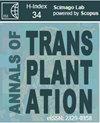Bioinformatics Identification of Candidate Biomarkers in Endomyocardial Biopsy and Peripheral Blood for Cardiac Allograft Rejection
IF 1.1
4区 医学
Q3 SURGERY
引用次数: 0
Abstract
Background Cardiac allograft rejection is still a crucial barrier to achieving satisfactory outcomes after surgery. In this study, we propose to find candidate biomarkers from endomyocardial biopsy (EMB) and peripheral blood (PB) samples for efficient diagnosis and treatment of cardiac allograft rejection. Material/Methods Microarray datasets were obtained from the Gene Expression Omnibus (GEO). Differentially expressed genes (DEGs) of cardiac allograft rejection patients and control subjects from EMB and PB samples were screened using the online tool GEO2R. Gene ontology (GO) and Kyoto Encyclopedia of Genes and Genomes (KEGG) pathway enrichment analysis of all samples’ DEGs were performed with the DAVID online tool. Protein–protein interaction (PPI) networks were constructed and visualized using Cytoscape and the top 10 hub genes were selected. Finally, the most highly enriched GO and KEGG pathways of the top 10 hub genes were determined. Results A total of 57 502 genes from EMB samples and 131 624 genes from PB samples were identified. Gene characteristics and enrichment analysis indicated that both EMB and PB samples contained DEGs involved in antigen presentation, immune cells activation, inflammatory process, and cellular injuries. In EMB samples, there were some DEGs related to heart tissue injury and cardiac malfunction. Moreover, DEGs that regulates hypoxia-induced factors and erythrocyte function in response of ischemia and hypoxia stress were present in PB samples but were absent in EMB samples. Conclusions The screened differentially expressed genes (DEGs) from EMB and PB samples of patients with cardiac graft rejection are potential candidate biomarkers of diagnosis and treatment.异体心脏移植排斥反应的候选生物标志物的生物信息学鉴定
背景:同种异体心脏移植排斥反应仍然是术后取得满意结果的关键障碍。在这项研究中,我们建议从心肌内膜活检(EMB)和外周血(PB)样本中寻找候选生物标志物,以有效诊断和治疗同种异体心脏移植排斥反应。材料/方法从Gene Expression Omnibus (GEO)获得微阵列数据集。使用在线工具GEO2R筛选EMB和PB样本中同种异体心脏移植排斥患者和对照组的差异表达基因(DEGs)。使用DAVID在线工具对所有样品的基因本体(GO)和京都基因与基因组百科全书(KEGG)途径进行富集分析。利用Cytoscape构建蛋白-蛋白相互作用(PPI)网络并进行可视化分析,筛选出前10个中心基因。最后,确定了前10个枢纽基因中富集程度最高的GO和KEGG通路。结果EMB和PB分别鉴定出57 502个和131 624个基因。基因特征和富集分析表明,EMB和PB样品均含有参与抗原呈递、免疫细胞活化、炎症过程和细胞损伤的DEGs。在EMB样品中,存在一些与心脏组织损伤和心功能障碍相关的deg。此外,PB样品中存在调节缺氧诱导因子和红细胞功能以应对缺血和缺氧应激的DEGs,而EMB样品中不存在。结论从心脏移植排斥反应患者的EMB和PB样本中筛选到的差异表达基因(DEGs)是诊断和治疗的潜在候选生物标志物。
本文章由计算机程序翻译,如有差异,请以英文原文为准。
求助全文
约1分钟内获得全文
求助全文
来源期刊
CiteScore
2.50
自引率
0.00%
发文量
79
审稿时长
>12 weeks
期刊介绍:
Annals of Transplantation is one of the fast-developing journals open to all scientists and fields of transplant medicine and related research. The journal is published quarterly and provides extensive coverage of the most important advances in transplantation.
Using an electronic on-line submission and peer review tracking system, Annals of Transplantation is committed to rapid review and publication. The average time to first decision is around 3-4 weeks. Time to publication of accepted manuscripts continues to be shortened, with the Editorial team committed to a goal of 3 months from acceptance to publication.
Expert reseachers and clinicians from around the world contribute original Articles, Review Papers, Case Reports and Special Reports in every pertinent specialty, providing a lot of arguments for discussion of exciting developments and controversies in the field.

 求助内容:
求助内容: 应助结果提醒方式:
应助结果提醒方式:


